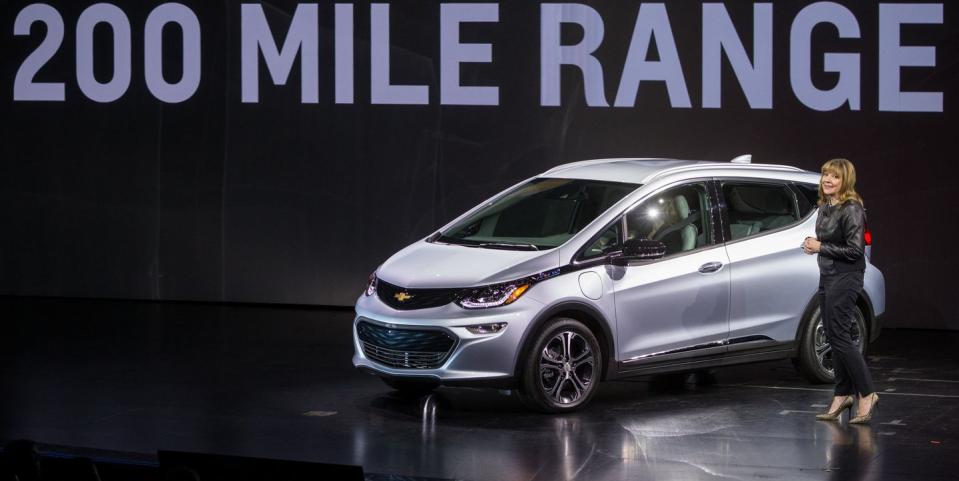In Radio Interview, GM CEO Barra Hints Chevy Bolt Could Return

Although the Chevy Bolt is going away, GM CEO Mary Barra talked up the compact EV in an interview with radio host Kai Ryssdal.
“That’s an important vehicle in our portfolio,” she said. (Barra is shown above introducing the Bolt at CES in 2016.)
Barra talked about the importance of leveraging GM’s “better-known” vehicle nameplates, and the Bolt would certainly qualify.
General Motors’ affordable, premier electric vehicle of the last six years, the Chevrolet Bolt hatchback (and larger Bolt EUV) ends production by the time the model year changeover from 2023 to ’24 takes place this summer.
Now it looks like it could be coming back in the near future.
“Bolt is something that has built up a lot of loyalty and equity,” GM CEO Mary Barra told radio host Kai Ryssdal in a nearly 30-minute long interview from Warren, Michigan, mostly about the automaker’s EV push, on American Public Media’s Marketplace Thursday. “So, I can’t say because I don’t discuss product programs, but … it was probably a move from second-generation to third-generation” battery technology, “but that’s an important vehicle in our portfolio.”
“Nudge-nudge, wink-wink, I guess,” Ryssdal responds.
The exchange follows a portion of Q&A in which Barra explains the difference between the Chevy Bolt/Bolt EUV, which GM announced in its first-quarter investor analyst call would end production after the 2023 model year. It is powered by GM’s second-generation battery technology, while every GM EV since—from the GMC Hummer and Cadillac Lyriq to the coming Chevy Silverado EV and Equinox EV—ride on the ultra-flexible Ultium battery system and skateboard platform.
“The difference between our second-generation and third-generation technology, which is Ultium, is a 40% reduction in battery cost, and we’re leveraging the names of our vehicles that are better-known in the industry,” Barra explains. “People who drive an Equinox today will understand what an Equinox EV delivers to them.”
The Bolt would also qualify as a “better-known” Chevrolet nameplate, and the publicly announced Ultium lineup to date does not have a compact vehicle the size of the Bolt. It could slot in nicely below the Equinox. Like the Chevrolet Volt extended-range electric that preceded it, the Bolt has a small but loyal following, and generally has been well-reviewed by the automotive press. It is, for one thing, fun to drive.
With the Bolt about to end production after two generations, it’s hard not to think of it as a modern-day Corvair (minus the Ralph Nader problem), which was a well-reviewed two-generation “premium” Chevy compact that deserved a longer lifespan (not to mention the experimental circa 1966 Electrovair). A Mark III, Ultium-based Chevy Bolt will be a welcome thing.
Is it smart for Chevy to bring back a next-generation Bolt EV on an updated battery architecture? Please comment below.

 Yahoo Autos
Yahoo Autos 